| Spectrum Software Scene |
OBSESSED with rubbish after a lifetime of emptying the bins of suburbia, Trashman, that Napoleon of garbage, is off to foreign parts to teach the world a thing or two about litter.
Travel With Trashman sets our hero the mission of flying to various famous tourist spots to deal with the rubbish problem. They include collecting roses from a Spanish bullring, coconuts from a Samoan beach, and secret papers fluttering from the windows of the KGB offices on the Red Square.
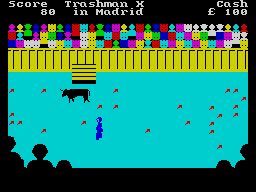
Trashman was greatly admired for its superlative graphics, but unfortunately the sequel does not match the earlier program in that respect. It is true that the thirteen screens are all completely different, whereas Trashman was built around various streets using the same few houses in different configurations, but there are too many occasions where colours flicker and change messily. Were that not the case, the graphics would be excellent, but as it is you are forced to conclude that New Generation has overreached itself slightly in designing screens too complex.
That does not, however, make the game any the less addictive, and on that score Travel with Trashman is a worthy successor to the original. You start with a fixed sum of money, with which to buy a ticket to a variety of destinations. The money is replenished according to your success in clearing up the rubbish at each location. That allows the player to try at least three screens immediately, even though unable to complete them. It also requires some tactical thinking from the more experienced player, in order to travel as cheaply as possible while still visiting all the locations.
As ever, New Generation has included its own style of humour in the game, not only with the visual gags about what constitutes foreign rubbish, but also with comments on the screen. The comments occur when Trashman bumps into the locals while attempting to do his job, such as tangling with French waitresses at a Parisian cafe, or upsetting the efficient service at the Munich beer festival.
Most of the humour is based on excruciating language jokes, such as 'Getenze artz a vay' in Germany. By and large, the jokes are inoffensive, although more likely to produce groans than laughs. However, the scene in Benares, where Trashman has to collect the sandals of the faithful as they immerse themselves in the Ganges, is rather more disturbing. Apart from the concept of making fun out of religious beliefs, which also occurs at the Wailing Wall in Jerusalem, the line 'Hurry curry Trashman' is at best puerile and at worst offensive. If that was the best the company could think of, it should have left the screen out altogether.
If you are impervious to that sort of humour, and do not expect miracles of graphics programming, you will find the game great fun to play and highly addictive. There is a considerable range of difficulty in the various screens, and although the mechanics of picking up litter remain the same, you will have to change your tactics to suit each particular situation.
It is a pity, therefore, that New Generation could not have taken more care with the graphics and humour.
Chris Bourne
| TRAVEL WITH TRASHMAN | Memory: 48K | Price: £5.95 | Joystick: Kempston, Sinclair, Cursor | Gilbert Factor: 7 |
BUZZ OFF from Electric Software is a fruity little program starring Bertie the Bee whose longing for sweet ripe strawberries and other assorted fruit gets him into a lot of trouble. He enters the Enchanted Orchard where his heart's desire hangs temptingly. Little does he know that a large spider is waiting for a wee bite too.
You must manoeuvre the bee around the screen collecting pieces of fruit as they appear. Once a piece has been eaten a portion of spider's web takes its place. If Bertie touches any part of the web down comes the nasty arachnid to collect his own lunch.
There are ten levels. In the first no web segments are visible but thereafter the spider will have spun bits of web to hinder Bertie in his task. As Bertie only moves in a straight line - bees do don't they? - getting round the screen is very difficult and the game requires large doses of concentration and care. The graphics are well-drawn, though necessarily limited to the bee, the spider and the fruit. The spider is distinctly menacing though Bertie looks rather bumbly.
This is the sort of arcade game you'll either adore or detest. Bertie's job is hard and there is no zapping or violence on the player's side. Skill and judgement are needed for success and the game concept is limited to the one task. Buzz Off is a good representative of this type of fruit game but runs the risk of repetition after a while.
Richard Price
| BUZZ OFF | Memory: 48K | Price: £4.95 | Joystick: Kempston, Sinclair | Gilbert Factor: 5 |
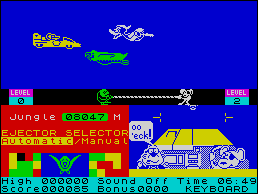
PENFOLD would certainly have approved of his rodent pal's adventures in Dangermouse in Double Trouble, from Creative Sparks.
It is a simple tale of terror in which the evil Baron Greenback, the turtle who is always trying to land Danger and Penfold in the soup, decides to create an Android Dangermouse. There are three episodes, reminiscent of the television series, in which you have to get the terrible twosome through to the computerised robot factory.
The first screen shows Dangermouse in his aerocar under attack from robots which must be shot by musical notes. As each is shot the score increases and the display showing you and Greenback in a tug of war changes so that you are winning the struggle. Every robot which hits you makes the turtle give an extra pull, which takes you further from your goal.
The jungle scenario of screen two, in which you have to jump on a crocodile and avoid the big cats and monkeys, leads to the final confrontation. Here Dangermouse must extinguish all the lights in the power matrix to destroy his double while avoiding Penfold who is being chased by Nero.
The game should keep any ageing youngster entertained for hours and the only danger is that the real youngsters will not get a look-in.
Dangermouse in Double Trouble would make a great Christmas present. We will certainly be asking Santa for future adventures starring the intrepid hero.
John Gilbert
| DANGERMOUSE IN DOUBLE TROUBLE | Memory: 48K | Price: £6.95 | Joystick: Kempston, ZX, Protek, Fuller | Gilbert Factor: 8 |
MOVING in the same direction as the film industry, Quicksilva has made the horror quantum leap from giant ants to zombies. Following the trail blazed by 3D Ant Attack, the company has now released Zombie Zombie, using the same softsolid technique which popularised the former.
Softsolid is a means by which a true 3D perspective is built up using 'solid' cubes to form structures, behind which you or the monsters lurk. The landscape is a ruined city, many times larger than the screen, which may be viewed from any of four directions, thus enabling you to see behind the walls.
You have a small helicopter, casting the now fashionable shadow when aloft, which can pick up and redistribute the bricks of the city. That enables you to cut off or channel the zombies to a suitable killing ground.
Destroying zombies is much more difficult than killing ants. The only apparent way of doing it is to lure a zombie up a set of steps and over a precipice. You are capable of surviving the drop, but the zombie goes splat and leaves a small red puddle.
The game is less playable than 3D Ant Attack, despite the welcome provision of joystick options. Whereas the ants used to swarm in large numbers around you if you stood still, the zombies are difficult to find. That, coupled with the enormous difficulty in destroying them, makes it more fun to potter around designing buildings with the helicopter rather than get on with the game.
Chris Bourne
| ZOMBIE ZOMBIE | Memory: 48K | Price: £6.95 | Joystick: Kempston, Sinclair, Cursor | Gilbert Factor: 7 |
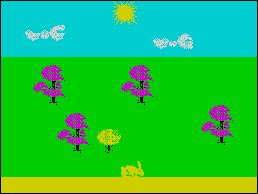
THE MOST SENSIBLE motive for buying Hareraiser is the sincere need to get rich.
The sole aim of the program is the discovery of a Golden Hare somewhere in the game landscape. Do not assume you are getting a fancy version of Kit Williams' Masquerade with complex graphics and a vast expansive plot.
The 'game' consists of a number of lacklustre, stark and simple screens depicting the countryside, with an occasional hare bouncing around and then disappearing. At the bottom of each of those thoroughly dull pictures appears an obscure phrase which may or may not help you to find the hare - or your £30,000 in lieu.
If you decide to persist with the puzzle you will still have to buy a second program before completing it.
The cassette insert provides details on how to enter. The only instructions on screen tell you to follow the hare with cursor keys. There seems to be no evidence of the richness of the original book.
Quite honestly, it is rather difficult to understand why this program was produced at all, though cynics may draw their own conclusions. Me, I'm going to zap a few aliens instead.
Richard Price
| HARERAISER | Memory: 48K | Price: £8.95 | Gilbert Factor: 3 |
YOU MAY HAVE experienced any number of flight simulation programs in which you take a single-seater biplane up into the wild blue yonder. Now for something completely different.
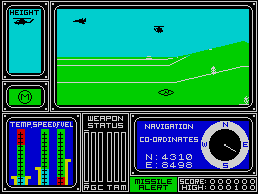
Combat Lynx, from Durell, is not as tame as the programs from Psion or Protek. You can hover, dip and rise in a battle-worthy helicopter, bombing the enemy, aircraft gliding like sitting ducks into the range-finder and which can be despatched quickly with an air-to-air missile or rapid fire from one of your machine guns.
Despite what you might be led to believe the game is about defence and not offence. You must defend three of six ground bases, making sure that the enemy does not get to them on foot or in the air.
Once you have equipped your machine with something from the choice of missiles and guns, using the educational schematic plans of the helicopter, you can start the game and launch into a combat zone represented in 3D. The helicopter representation is only adequate but the shifting hills and dales over which it flies give the necessary realism to what is a relatively true-to-life battle simulation.
The game is too much of a simulation. Beginners will find it difficult to get anything within their sights and flying the helicopter without an enemy to hound you will prove that Combat Lynx is for the dedicated performer who likes to impress friends with displays of dexterity at the keyboard. Arcade gamers might find it tedious because of the lack of immediate excitement. If, however, you are a level-headed player who likes to take time in developing skills Combat Lynx will pay off.
John Gilbert
| COMBAT LYNX | Memory: 48K | Price: £8.95 | Joystick: Any programmable | Gilbert Factor: 8 |
BOOKWARE seems to be the up and coming style in adventure these days.
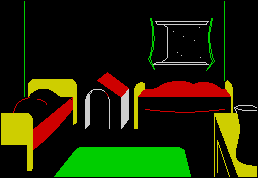
Hodder & Stoughton have entered the field with a rendering of JM Barrie's Peter Pan, a much loved classic. The program was written by Soft Option and is an interactive adventure with graphics. The action follows the book closely.
All the usual characters show up and you will have a tough time avoiding Hook and his villainous crew, the crocodile and the multitude of dangers in Neverland. Descriptions are full and the atmosphere is improved by the finely drawn graphic screens. Those are animated in the sense that some motion will be included in the picture. The children are shown flying across the sky, shark fins cut the water in the bay and puffs of smoke will rise from the chimney on the little house. The graphics are very attractive but do take a little time to draw. If you are impatient the pictures can be turned off.
Peter Pan has most of the standard adventure features though it is not too good at understanding abbreviations. The characters move quickly around the landscape and it can be quite an effort to keep up with some of them. The interpreter is not as obviously sophisticated as The Hobbit's.
Nevertheless, the game is well produced and should have a strong appeal to fans of the boy wonder and his band of lost adventurers. It is also nice to know that Barrie's royalties will be passed onto Great Ormond Street children's hospital. Peter Pan should make a good Christmas present.
Richard Price
| PETER PAN | Memory: 48K | Price: £9.95 | Gilbert Factor: 6 |
STOP. Taking your driving test? Now there is a program to test your ability and help you learn.
Highway Code is made up of five sections each containing approximately 30 questions on motorways, signs giving positive orders, warning signs, general signs and negative order signs. Each question has multi-choice answers some of which are very amusing, together with clear colour graphics of the road signs.
To gain access to each set of headings you must keep reloading the tape and stopping. Unfortunately, the program can be unfriendly at times as it does not always instruct you where to stop.
The second side of the tape contains a demonstration with questions on the traffic light sequence and a demonstration only of the procedure at a level crossing.
Highway Code is produced by Learning Systems to 'complement the HMSO booklet The Highway Code' and I suggest you treat it as such. The tape is instructive for experienced drivers and learners alike, but it is not as comprehensive a guide to the highway code as the HMSO version.
Colette McDermott
| HIGHWAY CODE | Memory: 48K | Price: £6.95 | Gilbert Factor: 6 |
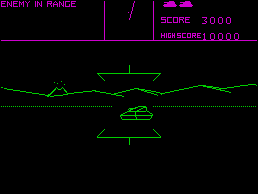
IT WOULD have been better if Atari had not given its permission to Quicksilva to produce Battle Zone as the game is no better than the original arcade version. Many companies at least try to add a new element to such games or put something extra into the graphics.
If by now you have not heard of the game the object is to move your tank around a landscape in which other tanks, space craft and flying saucers are on the prowl.
The bare instructions, found in the game and not on the cassette insert, tell you to hide behind objects which are littered around so that the enemy cannot see you before you make your move. The movement of your tank is difficult to master as the tank is on tracks. If you press the left-hand side of the keyboard the left track moves forward shifting the tank right, and if you push the right-hand keys the tank moves left. Time to reach for the Kempston joystick.
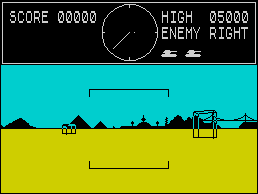
Forward movement shows the clumsiness of the 3D graphics which are inferior to the original. Outlines crack up, objects jerk when they move and missiles on target do not always score a hit.
While no better than Battlezone the Real Time Software 3D Tank Duel does have a coloured landscape, the former being only green and black. The standard of graphics is slightly better than the Quicksilva version and the action is smoother but the tanks, spaceships and flying saucers move faster than your gun sights which will cause a problem if you are lucky enough not to have played the game before.
The instructions and key layout are better than the Quicksilva version so at least you can use the cassette insert if you need reminding about controls during play.
Neither of these games have much to recommend them except that you do not have to pay 50 pence a time to play in an arcade. If you are after classic original arcade simulations then both games are good buys. If you want excitement from your computer then just pass them by.
John Gilbert
| BATTLE ZONE | Memory: 48K | Price: £6.95 | Joystick: Kempston | Gilbert Factor: 5 |
| 3D TANK DUEL | Memory: 48K | Price: £5.95 | Joystick: Kempston, Sinclair, Cursor | Gilbert Factor: 6 |
KNOCK, KNOCK, Who's here. The Doctor's back, in search of The Key to Time.
This new text adventure from Lumpsoft features the veteran time traveller and many of his oldest enemies, battling it out through time and space. Davros, Daleks, Cybermen and fellow time-lords all show up as you steer your Tardis through the ages.
With the aid of a timescanner you must discover the scattered pieces of the great key and presumably save the universe into the bargain. Before you can begin the quest you will have to learn how to operate the Tardis.
Addicts of the TV series will find themselves in a well-known environment but the program is very friendly and will give considerable help to those who are less familiar with the bumbling doctor.
The program is responsive and versatile whilst the riddles are by no means obvious. It will get you zipping back and forth through time like nobody's business.
The Key to Time is good-humoured, well written and a joy to play.
Richard Price
| THE KEY TO TIME | Memory: 48K | Price: £5.95 | Gilbert Factor: 7 |
FUNNY isn't it? Sometimes the games with the most simple of concepts can give just as much pleasure as programs of great complexity.
Tiler Tim by Microwish asks you only to move a grinning face across a grid pattern on the screen, avoid a deadly spider who dogs your tracks and occasionally stop another ghost-like character from undoing your good work of turning each small square into a different colour.
It is a cross between a painting game and Pacman, though there aren't any gobblers or killer ghosts. You move up a level after all the small squares have been changed and the action is progressively more difficult.
The graphics are bright and cheerful in almost fluorescent shades. Tim, the grinning face, zips across the screen at a fair pace making a noise like a geiger counter gone bananas.
No great strategic skills are necessary as the only real qualification to play is a quick eye and an even quicker hand. At first the spider seems sluggish but soon becomes a real hazard. Just as you think you have finished a screen the ghosts appear and you must stop them ruining your job.
Tiler Tim is very much a high-score merchant's game, deceptively easy and quite compelling.
Richard Price
| TILER TIM | Memory: 48K | Price: £5.95 | Joystick: Kempston, Cursor | Gilbert Factor: 6 |
MOST adventurers will find themselves at home in the world of Kentilla, a new mixed text and graphics game from Micromega.
Caraland is a place of magic, strange beings and heroes. A vile wizard, Grako by name, rules from his dark tower and spreads evil and destruction abroad. He possesses a moonstone, the source of his power and unless he can be defeated he will become undisputed ruler of Caraland.
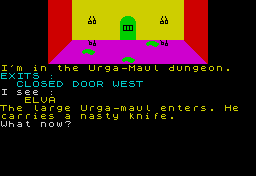
Your role is, naturally, that of the budding hero and you must explore the scorched wastelands, caves and forests to find the means to defeat Grako. Urga-mauls, the local orc equivalents, will treat you with scorn and violence and you may be able to get help from Elva, a creature or person who will follow you rather like Thorin does in The Hobbit.
The overall plot is familiar and takes bits and pieces from many adventure sources. Indeed, Velnor himself - remember Velnor? - gets a mention in the credits.
The insert tells you straight away that the game is devious and gives little clues as to how best to progress in Caraland. The game is described as interactive and the varied beings will react to you in quite understandable ways. The amiable cavezats - rather ponderous cavern dwellers - will treat you amiably until you attack and will then go all out to slay you.
Speaking to characters may get results but they do not appear to be overly responsive. The graphics are clear and colourful and almost instantaneous, whilst the interpreter will accept a wide range of input.
There are a number of useful features - such as recall of the last command - and the cursor can be moved through an entry enabling correction. Despite those features the game seems slow moving and it is all too easy to spend time getting hardly anywhere at all. That is an obvious disadvantage and may well mean the program is just too devious for the average adventurer. Time will tell.
Richard Price
| KENTILLA | Memory: 48K | Price: £6.95 | Gilbert Factor: 6 |
YOU ARE a Wally, trapped in a nightmare in which familiar objects turn on you as you desperately try to escape from the manic dreamscape. All you have to do to wake up is find the alarm clock.
According to Pyjamarama, an hilarious arcade adventure with stunning sprite graphics, a Wally's idea of a nightmare means being hit by roast chickens, bowled over by spinning dinner plates, attacked by an astral machete, or buzzed by revolving saws. After all, that is what makes a Wally.
In order to reach the alarm clock you have to travel through rooms in which your wildest fantasies are acted out. The ceiling in one room is made up of a gigantic space invader game in which you must blast the invading aliens.
On your travels you must take time to pick up objects which may or may not be useful in the completion of your quest.
A variety of objects dog your movement but the secret passages, found on the ground floor within barrels, should speed you on your way. Bouncing upstairs and sliding down the bannisters will also bring the object of your quest nearer.
Once you have dodged the chicken bombardment, the flying scissors and the falling books you are beset by ghosts in the cellar. Some of the objects are not so familiar - not even Wally could expect a magnet under the table or a rocket in the hall.
The action, plot and graphics of Pyjamarama from MikroGen are great. This Wally is a winner.
John Gilbert
| PYJAMARAMA | Memory: 48K | Price: £6.95 | Gilbert Factor: 8 |
RIGHT FROM the beginning you realise you are up against it in Eye of Bain, the new Artic text adventure. There you are, tied to a pole in some stinking hovel, praying to every god you have ever heard of in the hope you will escape before the natives decide to have a snack between meals.
Being a fairly mighty warrior you have travelled to this awful place in search of a fabulously huge sacred emerald. The gem is called the Eye of Bain and lies hidden in the temple, somewhere near that loathsome village.
Life is not going to be easy. Once you have escaped you will have to avoid endless perils and solve numerous tricky puzzles to reach the holy precincts. Crooked pirates, nasty nomads and killer bees are merely a few of the problems you will encounter - and have you ever tried to persuade an ape to give you a spot of help?
The adventure follows the usual Artic format though if you 'Look' you will be shown a picture of your location. That is a sensible approach to graphics as no time need be wasted unless you feel like it.
Input is in the standard verb-noun combination but multiple entries can be made by putting a full stop between each instruction. That can save time but the interpreter responds very quickly anyway.
Artic seems to adopt a no-frills approach to their adventures. You may not get animated graphics or the chance to enter full sentences but you can be fairly sure of facing constant challenges and original problems. Eye of Bain continues this tradition and should provide many hours of solid entertainment. Great value.
Richard Price
| EYE OF BAIN | Memory: 48K | Price: £6.95 | Gilbert Factor: 7 |
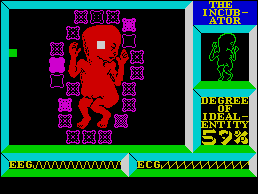
PLAYING THE part of a mouse dropping may not be everybody's idea of fun or even good taste but you will soon forget that representation when you start to play the new Automata masterpiece, Deus Ex Machina.
The plot seems simple enough. It takes place in the rules the political roost. The last mouse crawls to its extinction within the machine and as the nerve gas kills it the ultimate mouse dropping is released by the rodent.
That is taken into the machine and the game, which takes up two sides of a cassette tape and an audio soundtrack, starts in which you must create a lifeform within the machine. You can take that lifeform, if it survives, from birth through middle age to old age, playing a series of weird games. Those make more sense when you listen to the soundtrack and realise that author Mel Croucher is trying to put a series of complex political, philosophical and theological points across.
The scenario is created, almost psychedelically, within the mind of the player with a background coloured by shades of Orwell's 1984. When you have been born you are tested by the Defect Police who want to know everything about you. They probe you with their emotionless eyes, blinking out of the darkness and trying to discover the secret of your body and what lies within.
The game even depicts the life form's first sexual encounter, frightening and automated. The emotions evoked are standard and, of course, part of the system.
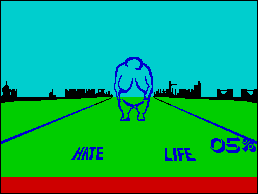
As old age creeps into the game, on the second side of the tape, you suddenly discover that it is not just the forces of government which are attacking you. Your body rebels as it grows old, and towards the end of the game you will have to fight blood clots and red cell destruction from within. Even that system which you trust all your life lets you down in the end.
Mel Croucher does however, give you some hope as your body dies. The final image is of a spinning embryo, one of the first images of the game. The circle is complete and even an accident rarely disrupts the system.
The game and its soundtrack, featuring the talents of John Pertwee, Ian Dury, Donna Bailey, Frankie Howerd, E P Thompson and Mel Croucher, is a revolution in gaming technology. It has its genesis in the concept record album of the late 1960s and 1970s.
Croucher has cleverly manipulated the elements of computer gaming and brought in concepts usually found only in movies. The result is a piece of software which even those people who usually find games boring and computers even more so, will enjoy and play time and again. That is not to say, however, that the program is only for those who enjoy deep thought. Automata would have been foolish not to include classic elements of the arcade within its novel conceptual twists.
In the final analysis Deus Ex Machina is a game to be played first and talked about later. So, go ahead and do it. We won't look but we will guarantee - well, almost - that you will be intrigued.
John Gilbert
| DEUS EX MACHINA | Memory: 48K | Price: £15.00 | Joystick: Kempston, ZX | Gilbert Factor: 9 |
WHEN YOU saddle up to play Stagecoach from Creative Sparks make darn sure that you put a lot of cotton wool in your strides or you will end up pretty sore in the nether regions - well, the cowboy, on screen will anyway.
The game is an attractively animated Western split into three main sections. The jump comes first. There you are moseying over the desert when suddenly the stage appears. It is driverless, swaying and jolting all over the place.
The idea is to steer your cowboy up to the stage and get him onto the coach roof. Dead easy you may say, but unfortunately the desert is filled with large cacti and bits of junk. Collide with these and you will be thrown off your mount. You will have to remount and set off after the stage again, wasting precious time in collecting the horse.
If you finally get on the stage you take the reins and guide it through the obstacle course of the mountains. On the way passengers must be picked up along with boxes of gold. Then come the Indians, whooping around the coach and threatening to take your passengers. Standing on the roof your cowboy can shoot them down ... leaving the stage driverless again and prone to further collisions.
The graphics are excellent. The cartoon effect is very well done with bright colours and fairly smooth action. There are a number of different tasks, each needing skill and practice. Stagecoach is an exciting game, full of incident and variety.
Richard Price
| STAGECOACH | Memory: 48K | Price: £6.95 | Joystick: Kempston, Sinclair, Fuller, Protek | Gilbert Factor: 7 |
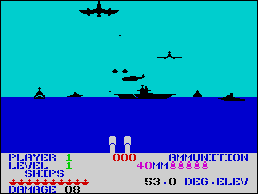
A CALL TO General Quarters and a beach head invasion are the stuff of which generals are made but Beach Head, a typical American import from US Gold, gives you the opportunity to fight the war single handed.
You guide your fleet around an aerial reconnaissance map making sure that you locate the enemy before they find you. Encounters at sea are shown in 3D with your ship's gun turrets at the bottom of the screen, firing salvos at the aircraft which fly in low releasing their bombs in suicidal strafing runs.
Once you have found the enemy base, hidden in a secret passage, and avoided torpedoes, rocks and mines, you can have a go at wreaking your revenge on the enemy.
The graphics used in the beach scenes and at sea are best experienced at least four feet from the computer where they appear to be realistic. Do not let that put you off what is an excellent game of arcade skill and strategy. It looks as if US Gold is intent on bringing the best of the US software to Britain. If this, its first conversion to the Spectrum, is anything to go by the American products should be well received.
John Gilbert
| BEACH HEAD | Memory: 48K | Price: £7.95 | Joystick: ZX, Protek, Kempston | Gilbert Factor: 8 |
BLACK HAWK is one of the world's most sophisticated aircraft, jam-packed with missiles, cannons and similar deadly weapons. Jump in the cockpit, take off and head towards the enemy coast. Your mission - yes, you have guessed it - is to blow up everything you can as effectively as possible. After you have done that you also have to get away in one piece.
There are two playing screens. The first is a long range missile-firing screen. As the ground moves below, various enemy installations and war-machines appear. Those are two-dimensional and scroll down the screen in a map-like fashion. The ultimate aim is to find and destroy the enemy airbase. Once fired, missiles can be guided to the target with your joystick or control keys. Getting the hang of that will take some practice.
The second screen is for defending the plane against hostiles who manage to get through your missile screen undamaged.
Most dangerous of all are the SAM missiles which seem to get faster and faster as you progress up the score table. Extra weapon-systems are fitted to the Hawk if you score certain percentages of target hits. More and more targets and threats will also appear. There are two playing modes - tough and tougher.
Creative Sparks has produced a shoot-em-up of some complexity and the action is furious. The missile firing sight can get confusing at times and is barely visible over water. Controls are as fast as your reactions.
It is not a simulation, it will not stretch your intellect but it is difficult and demanding.
Richard Price
| BLACK HAWK | Memory: 48K | Price: £6.95 | Joystick: Kempston, Sinclair, Fuller, AGF/Protek | Gilbert Factor: 7 |
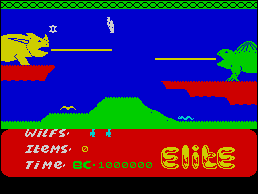
BULGING MUSCLES and a pair of wings makes Kokotoni Wilf one of the most unlikely heroes to fly into a game since the first space invader hatched from its egg above an earth base.
His mission, to find the lost pieces of an arcane amulet for the wizard Ulrich, is a serious affair in which he could be licked to death by a triceratops, zapped by a deadly egg or dropped on by a bat.
All those fates await the intrepid hero as he wings his way through several time zones and six lives in search of the fabled Dragon Amulet.
The graphics are as primitive as the dinosaurs which inhabit the upper levels of the game but the search, which can be compared with the search for drinking goblets in Jet Set Willy, is fun. Skill and cunning is required on the lower levels when Wilf encounters prehistoric alligators, swims through underground tunnels and gets hit by nocturnal seagulls.
Not having anything to fire at the monsters may put you off but for those who like to plan strategic play, and find a quiet corner of the screen, the game is excellent value.
John Gilbert
| KOKOTONI WILF | Memory: 48K | Price: £5.95 | Gilbert Factor: 6 |
ASTROPLANER, from Romik, might come as something of a shock, if your copy is packaged like the one received at Sinclair User.
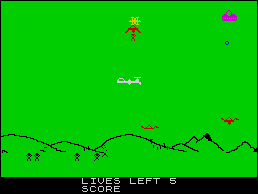
The cassette insert promises a game called Beatcha, about a school in which all the pupils must avoid the teachers. On loading, however, the program turns out to be a shoddy version of Defender which, to add insult to injury is mostly written in Basic with a few bytes of machine code added for good measure.
Why anyone would want to bring out yet another version of the traditional game is beyond reason. There are already many versions around for the Spectrum and to release yet another the manufacturer must either think it has exceptional graphics or that it contains a feature not included in other versions.
Unfortunately that is not the case it is a slow version of the standard 'stop the aliens dropping the refugees' story. The hilly terrain and spacecraft stand out on a violent green screen which plays tricks on the eyes, making the game difficult to play. The aliens look as if they have been imported from the Imagine Arcadia.
The keys are difficult to use because, with the copy we received, the main instructions about control of the spacecraft were given in the program. There are two keys which start the game. If the wrong key is pressed the player will not only not know what the game is about but will also have to press nearly every key to find the control and fire buttons.
The aliens against which the player has to pit wits belong in a school for the backwardly bug-eyed. You will get more action from a Venus flytrap.
Astroplaner is a definite disaster, a game to steer clear of unless you are making a collection of turkeys.
John Gilbert
| ASTROPLANER | Memory: 48K | Price: £5.95 | Gilbert Factor: 2 |
BY THE LIGHT of the bombers' moon a Lancaster weaves its way into enemy territory. Strapped in, shivering in the cold of high altitude, you clear the breeches of your machine guns and watch the night sky in apprehension. Barrage balloons drift across occasionally, but suddenly the speck you thought was a star grows into the shape of a twin engined night-fighter. Here they come. Jinking and banking the fighters swarm up, guns twinkling in the darkness.
Night Gunner from Digital Integration is a multi-task arcade scenario casting you in the role of the turret gunner of the Lancaster. The main screen features the night-fighter attack. Against the starry background the enemy planes zoom closer and, by using deflection shooting, you must knock them out before they cause serious damage to the bomber.
Pilot reports and damage status are shown beneath the screen and there are three bombers available. After surviving the fighters you progress to a ground attack screen in which you must either bomb various targets from above or dive the plane to take out enemy tanks with rockets. Flak or searchlights will hinder you.
During dive-bombing you need to watch the altimeter carefully as it is easy to crash into the ground. Once that is finished you make the return journey to base, again fighting off savage attacks. Difficulty is progressive and there are thirty missions all told.
The night fighter graphics are quite impressive and are fast, smooth and distinct. There is a good feel of a dogfight though the balloons sometimes seem a little out of place as they swerve across the sky. The other screens are not as accomplished but remain exciting and taxing. The overall style has similarities with Zzoom, making this shoot-em-up a compulsive and demanding program.
Richard Price
| NIGHT GUNNER | Memory: 48K | Price: £6.95 | Joystick: Kempston, AGF, Protek, Sinclair | Gilbert Factor: 6 |
HAMPSTEAD is, well, Afghans and jogging and all sorts of things. And Hampstead Man is, well, Jeremy - off to the city, playing squash, and taking Annabel and Toby out for a crêpe.
If you have ever wondered how Hampstead Man got there, you should try some software written by and for social climbers. Hampstead is not, after all, just a place - it's a way of life. And believe it or not, Hampstead Man may come from the humblest of origins.
To get to Hampstead with nothing but a UB40 and a tracksuit you have to know the form - what to wear, what to say, which newspaper, which muesli - and you may have to lie, cheat and steal to get there.
Collect the Wykehamist tie, passport to clubland and merchant banking and extract Art from an industrial labyrinth. Head off for Cambridge and Richmond - but be careful. Seek out Pippa, and then get round her father. Only when you have done all that are you ready for Hampstead.
Hampstead is a text-only adventure, written on the Quill. Using an all-purpose program limits the scope of the game, and Melbourne House, which produced The Hobbit, could have done better. A more serious irritation is a racist bias. Was it really necessary to have a grinning Pakistani in a north London Post Office, a 'foreign' voice on the station tannoy and middle eastern races selling hamburgers?
Despite its flaws you are sure to find Hampstead an entertaining romp up the social ladder.
Joanna Pegum
| HAMPSTEAD | Memory: 48K | Price: £9.95 | Gilbert Factor: 8 |

THROWING PLATES into the air and balancing them on poles might not be your idea of fun but obviously somebody at Ocean Software thinks that a Chinese Juggler makes a smashing game.
Your performer must take the plates from the piles set at the front of the stage and toss them into the air until they are the correct colour to onto one of the poles.
Once you achieve the correct coloured plate you can spin it on one of the poles and return for another. That continues, together with odd intervals where you must re-spin plates which are threatening to fall, until all of the poles have been used.
After initial interest wanes the game becomes slightly boring and then excruciatingly so. Each level is easy and once you have been past the eighth or ninth level there is not much left to do.
The game has proved popular for the Commodore 64 which probably confirms what you have always suspected of Commodore users.
John Gilbert
| CHINESE JUGGLER | Memory: 48K | Price: £6.90 | Gilbert Factor: 5 |
PAIN AND nausea sweep over you as you wake. Your head feels as if a troll has been using it as a football. Your mouth is dry and, judging by the darkness, your eyes are not doing too well either.
Slowly your vision returns and you make out a dim light. The stones beneath you are damp and cold and you finally realise that you are locked in a cell. Take a look round - there is only a chair. This is Vran Verusbel's dungeon and you are in it - right up to the neck.
So begins The Final Mission, last in the Ket Trilogy from Incentive. After a blow on the head at the end of the previous adventure our reluctant hero finds himself in a tight spot and must now escape to seek out and destroy Vran the vile necromancer.
The format remains pure text. Locations are boxed at the top of the screen and the score is displayed above the description - a useful idea as you will immediately notice if you perform some significant action. As ever, the interpreter is friendly and responds with variety and occasional flashes of humour.
Edgar, the assassin bug strapped to your neck, has become quite taciturn and is very sparing with help. When his tongue is loosed he will provide the occasional clue. Most of the time you are on your own in Vran's gloomy halls and subterranean passages. You will hear the patter of tiny feet and the crunch of giant ones behind you.
The problems are well up to standard, there is also the pull of the concluding portion of the prize winning sentence.
The Final Mission looks to be a fitting finale to the quest.
Richard Price
| THE FINAL MISSION | Memory: 48K | Price: £5.50 | Gilbert Factor: 7 |
BMXers beware. Somewhere out there is a castle full of ghosts and treasure ready to take you into its dreadful maw. Ghost Rider from Positive Image features an intrepid bike rider competing in such a spectral motocross. The game uses the platform format with the castle rooms split into six levels. The rider is shown as a silhouette figure pedalling away for dear life around the haunted pile.
Access to each level is by unpredictable elevators which must be ridden onto with some precision. Getting off the lifts is equally dangerous as there is only just enough space between roof and ceiling for the rider to fit.
Treasures such as crowns and golden cups are lying around on the platforms and all must be collected before you can go onto the next screen.
There are twelve screens each of increasing difficulty. The floors are patrolled by an assortment of ghosts and monsters all of which will kill our biker instantly if he makes a false move. The hazards are much the same on each screen though the structure of the platforms gets more fragmented.
On first sight the program seems relatively simple but in fact you must take great care to collect treasures in the correct order, or you will run out of fuel and be unable to reach the refuelling point in time. The golden cups are only accessible after the other minor items have been picked up and are often placed behind brick walls which create further obstacles.
Though the game is difficult and nerve-racking at times the graphics are rather bleak and flickery. The use of a white background results in a fair amount of glare and can be tiring after a while. The rather uninspiring presentation counts against the program. So does the fact that it is extremely temperamental about loading.
Richard Price
| GHOST RIDER | Memory: 48K | Price: £6.95 | Gilbert Factor: 4 |
THE MOST interesting thing about Gilligan's Gold from Ocean Software is the difference between the demonstration and what is actually possible. The game is set in a mine, and you control what looks like a pink teddy bear from marauding green bears as you collect gold.
The pink teddy in the demonstration had great fun digging out gold with a pick-axe and dashing up ladders and lifts to deposit his finds in a wheelbarrow. A favourite ruse is to drop a bag of gold down a mine shaft and onto an unsuspecting bear's head, causing him to collapse and see stars.
Sadly, our team found it near impossible to pick up the gold or pick-axe or to manoeuvre the wheelbarrow. We could not even make use of the pit bus, which would run down a bear as soon as look at one.
The speed and the attractive display show that it can be addictive.
Joanna Pegum
| GILLIGAN'S GOLD | Memory: 48K | Price: £5.90 | Gilbert Factor: 6 |